
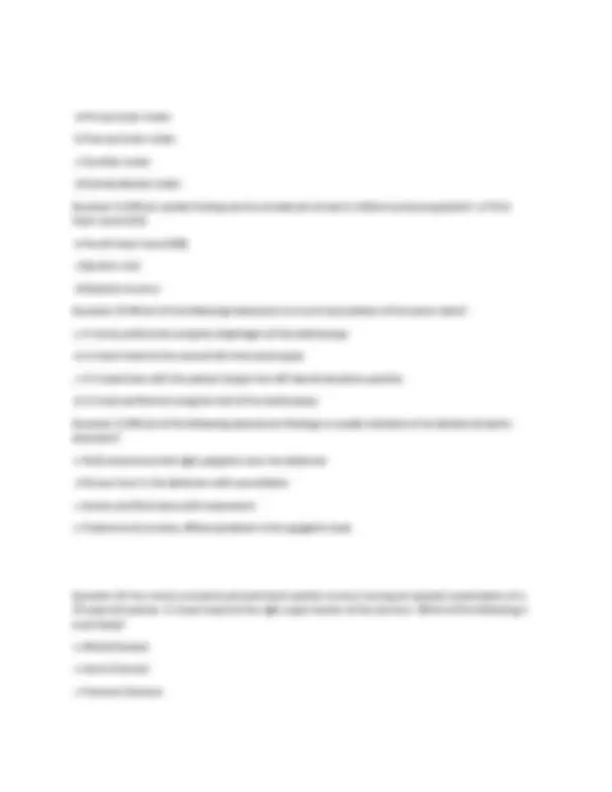
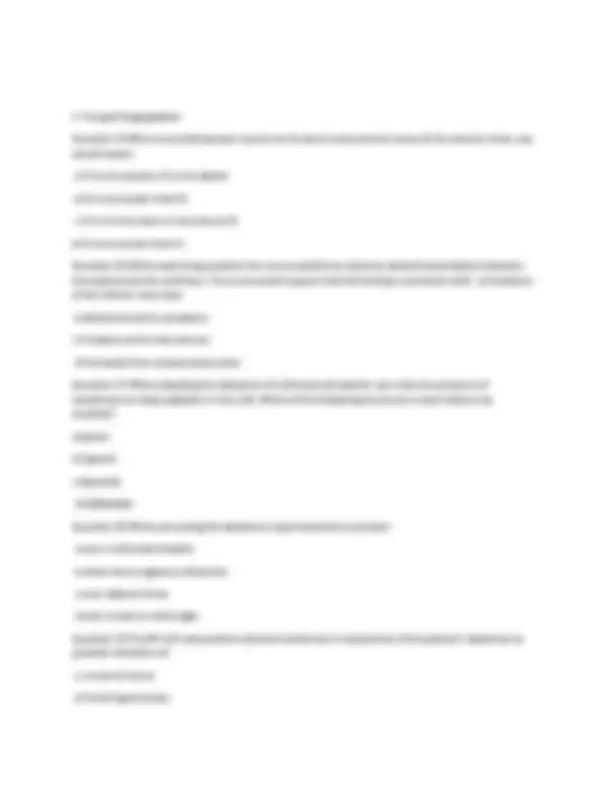
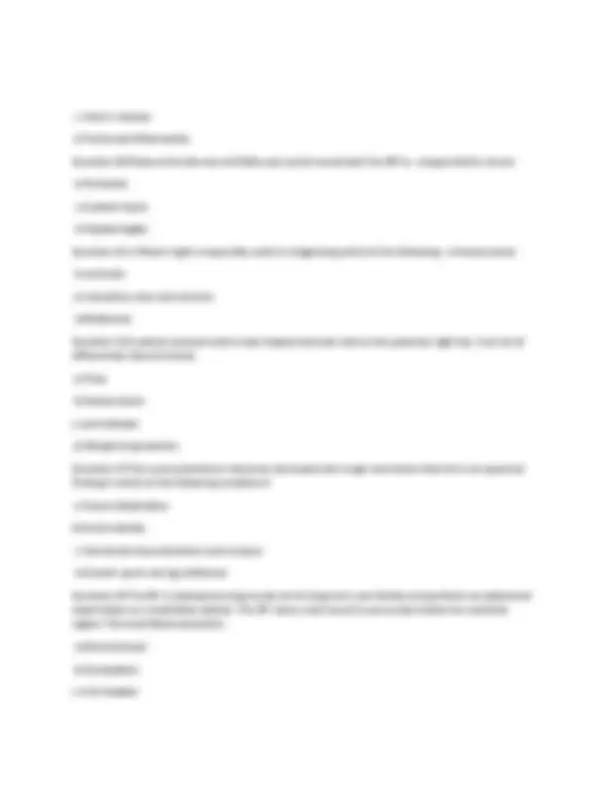
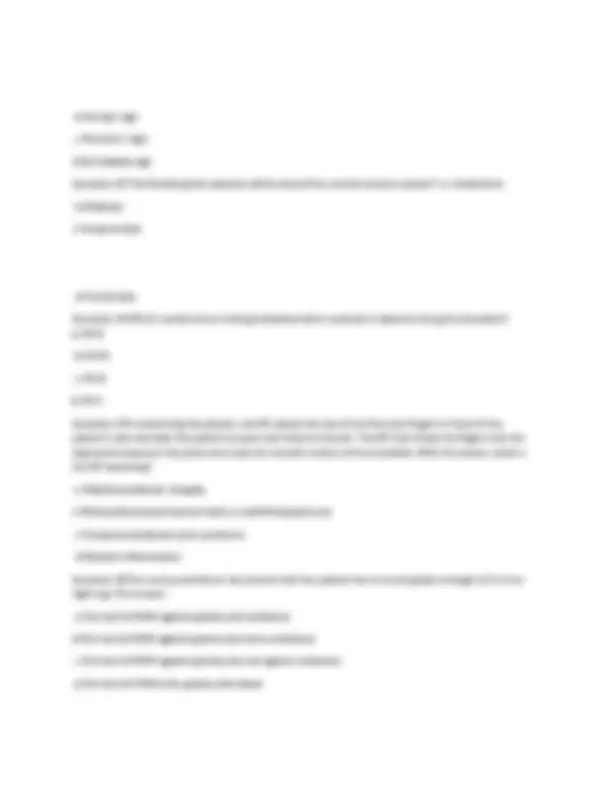
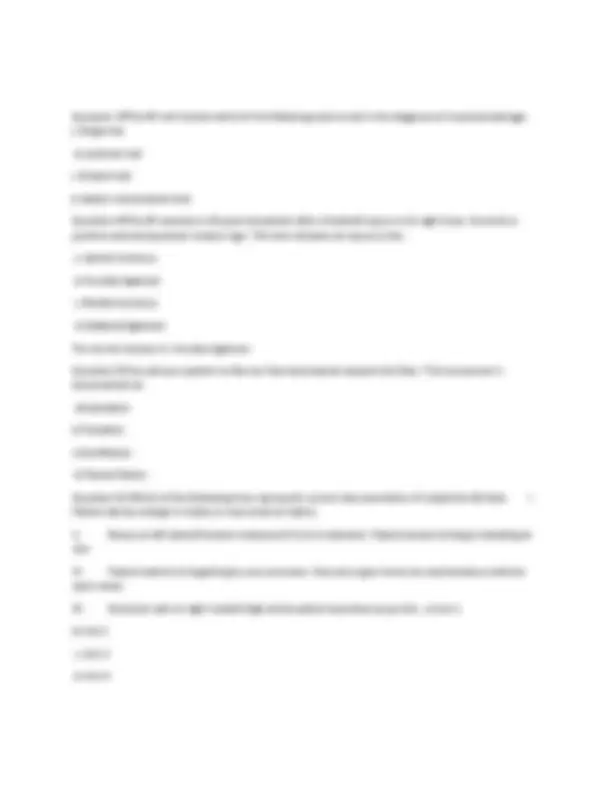
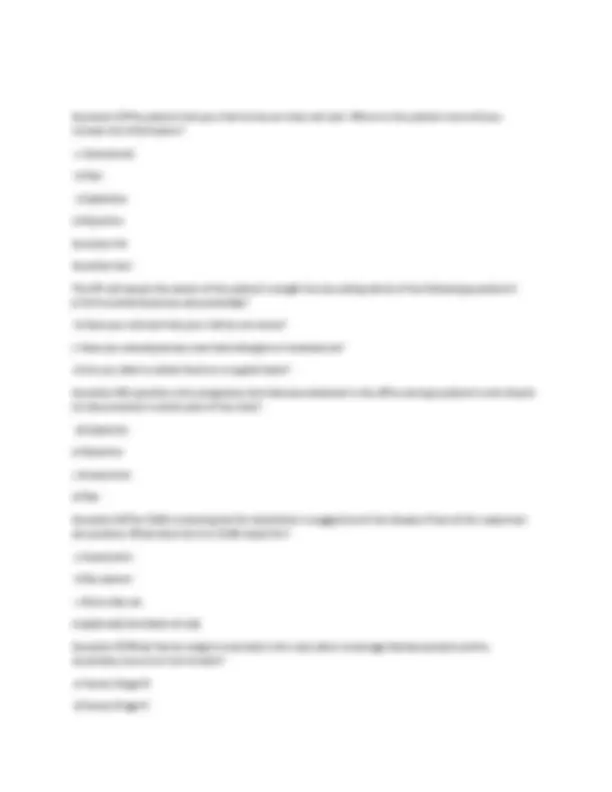


Study with the several resources on Docsity

Earn points by helping other students or get them with a premium plan


Prepare for your exams
Study with the several resources on Docsity

Earn points to download
Earn points by helping other students or get them with a premium plan
Community
Ask the community for help and clear up your study doubts
Discover the best universities in your country according to Docsity users
Free resources
Download our free guides on studying techniques, anxiety management strategies, and thesis advice from Docsity tutors
Question 1 When you are assessing the internal structures of the eye, absence of a red reflex may indicate: a. Cataract or hemorrhage into the vitreous humor b. Acute iritis c. A normal finding in older adults d. Diabetes or long-standing hypertension Question 2 Which of the following is the correct statement regarding the size of the arterioles and veins in the fundi of the eye? a.The veins and the arterioles are equal in size Incorrect: Veins will be visibly larger than the arterioles when performing a fundoscopic exam. b.The arterioles are larger than the veins c.The arterioles are half the size of the veins d.The veins are larger than the arterioles Question 3 A patient is diagnosed with conductive hearing loss in the left ear. Which of the following is the expected results on this patient when performing the Rinne test? a.BC>AC b. AC>BC c. Lateralization to the bad ear d.Lateralization to the good ear Question 4 When the NP places a vibrating tuning fork in the midline of
Typology: Exams
1 / 12

This page cannot be seen from the preview
Don't miss anything!







Question 1 When you are assessing the internal structures of the eye, absence of a red reflex may indicate: a. Cataract or hemorrhage into the vitreous humor b. Acute iritis c. A normal finding in older adults d. Diabetes or long-standing hypertension Question 2 Which of the following is the correct statement regarding the size of the arterioles and veins in the fundi of the eye? a. The veins and the arterioles are equal in size Incorrect: Veins will be visibly larger than the arterioles when performing a fundoscopic exam. b.The arterioles are larger than the veins c. The arterioles are half the size of the veins d. The veins are larger than the arterioles Question 3 A patient is diagnosed with conductive hearing loss in the left ear. Which of the following is the expected results on this patient when performing the Rinne test? a.BC>AC b. AC>BC c. Lateralization to the bad ear d.Lateralization to the good ear Question 4 When the NP places a vibrating tuning fork in the midline of a patient’s skull and asks if the tone sounds the same in both ears or is better is one, the examiner is performing: a. The Rinne test b. The Weber test c.the Proprioception test d.a hearing acuity test
Question 5 In a young child, unilateral purulent rhinitis is most often caused by: a.Bacterial infection b. Allergic rhinitis c. Viral infection d. Foreign body Question 6 A patient presents with pain and pressure over her cheeks and purulent nasal discharge. The NP cannot transilluminate the sinuses and will suspect that which common sinus may be affected? a.Maxillary sinus b. Ethmoid sinus c. Temporal sinus d. Frontal sinus Question 7 The NP suspects chronic allergy when he notes the following appearance of the patient’s nasal mucosa: a. Swollen and red b. Swollen, boggy, pale, and gray c.Hard, pale, and inflamed d.Bright pink and inflamed Question 8 The NP notes tenderness to palpation of the pre-auricular lymph nodes on examination. The appropriate action at this point is to: a. Perform a thorough examination of the ears b. Reexamine the nodes and carefully examine lymph nodes in other regions c. Assess the patient’s hearing d. Assess the patient’s temperature Question 9 To assess the position of the trachea, the NP will: a. Use tangential lighting and inspect the neck area b. Position the patient in a supine position at 15 degrees c. Auscultate the carotid arteries with the bell of the stethoscope d. Palpate the space between the trachea and sternocleidomastoid muscle Question 10 The lymph nodes located at the angle of the mandible are:
d. Tricuspid Regurgitation Question 15 When auscultating heart sounds at the aortic and pulmonic areas of the anterior chest, you would expect: a. S1 to be present, S2 to be absent b. S1 to be louder than S c. S1 to be the same in intensity as S d. S2 to be louder than S Question 16 While examining a patient the nurse practitioner observes abdominal pulsations between the xiphoid and the umbilicus. The nurse would suspect that this finding is consistent with: a.Pulsations of the inferior vena cava b.Abdominal aortic pulsations c.Pulsations of the iliac arteries d.Peristalsis from a bowel obstruction Question 17 When palpating the abdomen of a 20-year-old patient, you note the presence of tenderness on deep palpation in the LUQ. Which of the following structures is most likely to be involved? a.Spleen b.Sigmoid c.Appendix d.Gallbladder Question 18 When percussing the abdomen, hyperresonance is present: a.over a distended bladder b.when there is gaseous distention c.over adipose tissue d.over a mass or solid organ Question 19 The NP will note positive rebound tenderness in assessment of the patient’s abdomen as possible indication of: a. A ventral hernia b. Portal hypertension
c. Crohn’s disease d. Peritoneal inflammation Question 20 Rebound tenderness at McBurney’s point would alert the NP to: a.Appendicitis correct b.Peritonitis c.A spleen injury d.Hepatomegaly Question 21 A Wood’s light is especially useful in diagnosing which of the following: a.Herpes zoster b.versicolor c.A decubitus ulcer and necrosis d.Melanoma Question 22 A patient presents with a tear shaped vesicular rash on the posterior right hip. Your list of differentials should include: a. Tinea b. Herpes zoster c. Lyme disease d. Allergic drug reaction Question 23 The nurse practitioner discovers decreased skin turgor and knows that this is an expected finding in which of the following conditions? a. Severe dehydration b. Severe obesity c. Connected tissue disorders such as lupus d.Growth spurts during childhood Question 24 The NP is making morning rounds at the long term care facility and performs an abdominal examination on a bedridden patient. The NP notes a dull sound to percussion below the umbilical region. This most likely represents: a.Normal bowel b. Constipation c. A full bladder
d.Tonometry Question 30 The NP will recognize equal inspiratory and expiratory rates as normal with which breath sounds? a. Bronchial b. Bronchovesicular c.Vesicular d.Tracheal Question 31 Physical exam finding associated with a consolidation in the lung may include: a.Decreased tactile fremitus over the area of consolidation Incorrect: Percussion over a consolidated area of the lungs would result in a dull sound. Tactile fremitus would increase over the consolidation and whispered pectoriloquy would be more pronounced. b. Dull to percussion over the area of consolidation c. Resonant to percussion over the area of consolidation d. Mufled whispered pectorilquy Question 32 How will the NP assess cranial nerve XI? a. Ask the patient to say ‘ah’ b. Have the patient shrug his or her should while you resist the movement c. Have the patient stick out his or her tongue and move it from side to side d. Touch the pharynx with a cotton–tipped applicator Question 33 A patients presents to the clinic with complaints of a severe headache, fever, delirium, nausea, vomiting and a stiff neck. Which physical maneuver will the NP perform to help determine a diagnosis? a. Babinski reflex b.Hoffman’s sign c.Hoover’s sign d.Kernig’s sign Question 34 The NP is concerned about the possibility of meningitis in her 19 - year-old patient. She asks the patient to lie supine and flex his head to his chest. The NP is assessing the patient for what sign? a. Brudzinski sign
b. Kernig’s sign c. Meniere’s sign d.Dix-Hallpike sign Question 35 The Romberg test assesses which area of the central nervous system? a. Cerebellum b.Midbrain c.Temporal lobe d.Frontal lobe Question 36 Which cranial nerve is being evaluated when a patient is asked to shrug his shoulders? a. CN IX b. CN XII c. CN XI d. CN X Question 37In examining the patient, the NP places the tips of his first two fingers in front of the patient’s ears and asks the patient to open and close his mouth. The NP then drops his fingers into the depressed area over the joints and notes for smooth motion of the mandible. With this action, what is the NP assessing? a. Maxillomandibular integrity b. Well positioned permanent teeth or well-fitting dentures c.Temporomandibular joint syndrome d.Mastoid inflammation Question 38The nurse practitioner documents that her patient has a muscle grade strength of 3 in her right leg. This means: a. She has full ROM against gravity and resistance b. She has full ROM against gravity and some resistance c. She has full ROM against gravity and not against resistance d. She has full ROM with gravity eliminated
Question 43The patient tells you that he has an itchy red rash. Where in the patient note will you include this information? a. Assessment b.Plan c.Subjective d.Objective Question 44 Question text The NP will assess the extent of the patient’s weight loss by asking which of the following questions? a. Tell me what foods you ate yesterday? b. Have you noticed that your clothes are loose? c. Have you developed any new food allergies or intolerances? d. Are you able to obtain food on a regular basis? Question 45A positive urine pregnancy test that was obtained in the office during a patient's visit should be documented in which part of the note? a.Subjective b.Objective c.Assessment d.Plan Question 46The CAGE screening test for alcoholism is suggestive of the disease if two of the responses are positive. What does the E in CAGE stand for? a. Equal parts b. Eye opener c. Every day use d.(planned) End (date of use) Question 47What Tanner stage is recorded in the note when a teenage female presents with a secondary mound on her breasts? a. Tanner Stage VI b. Tanner Stage V
c. Tanner Stage IV d. Tanner Stage III Question 48Which of the following lines represents correct documentation of objective (O) data I. Patient denies change in moles or new onset of rashes. II. Patient denies itching or bleeding at site of nevus on left lateral forearm. III. Patient admits to forgetting to use sunscreen. IV. Vesicular rash on right medial thigh a. Line 1 b. Line 2 c. Line 3 d. Line 4 Question 49Which of the following lines represents correct documentation of subjective (S) data I. Patient reports tenderness to palpation of right upper quadrant of the abdomen II. Positive egophony noted when patient says ‘eeee’ repeatedly III. Patient reports having a bowel movement which was dark in color with obvious bright red blood IV. Patient’s vision in her right eye is tested at 20/40 a.Line 1 b. Line 2 c. Line 3 d. Line 4 Question 50The assessment (A) component of the SOAP note is used to document a. Physical assessment findings b. The provider’s interpretation of the findings c.Patient’s comprehensive health history d.Plan of care to address the patient’s identified problems